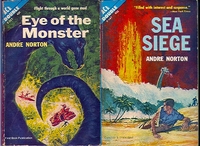I do get so tired of seeing headlines like "Will Ebooks Ever Completely Replace Print?"
I put such things up there with:
Half-life plot
I put such things up there with:
- Will Cars Ever Completely Replace Horses?
- Will Microwaves Ever Completely Replace Stoves/Ovens?
- Will Color TV Ever Completely Replace Black & White?
- Will TV Ever Completely Replace Movie Theaters?
- Will Talkies Every Completely Replace Silent Movies?
- Will Cell/Smart Phones Ever Completely Replace Land Lines?
- Will Cloth Ever Completely Replace Animal Skins?
- Will Self-Driving Cars Completely Replace Standard Cars?
Half-life plot
All that though doesn't mean that I don't love those printed books I've got in my library. But those books have meaning in time. Such as when at Atlantic Beach Elementary I saw my first Heinlein, Rocket Ship Galileo, or read Andre Norton's Ace Double that had Eye of the Monster and Sea Siege when I was visiting my aunt in New Hampshire and stayed in the cottage outside, and then later when I read Piper's Lord Kalvan of Otherwhen, and using the information I had learned went to Silver's Drug Store started working in chemistry (I did teach chemistry for a good number of years too), and then reading Pat Frank's Alas Babylon and knowing my home was in those first strike zones. All of these and so many more influenced me so much, some I read so many times that the glue in the spine gave out and are now single sheets store in a book cover that acts more like a folder. These are all things that I look back with fondness and warm feelings.
But just because I had those feelings, doesn't mean that I can't change to the new format. This change has occurred, for example back when paperbacks were first introduced, and I'm sure that when the change from scroll to codex, there were arguments too. With technology things change, and many people think that they will change so fast, but I think that that "fast" is only a hindsight view. After all Thomas A. Edison predicted back in 1913 that “Books,” declared the inventor with decision, “will soon be obsolete in the public schools." of course at the same time he was also a bit off about movies when he said “I do not think every home will have its own projecting machine, although the wealthier people will possess them, no doubt." textbooks were Change is occurring, but not necessarily as fast as some may think (or want) it to. Right now if you want, you can do pretty much all your reading on a device, but that pretty much isn't all. There are still a number of novels and textbooks that are only made available on printed paper. You had to wait from 1998 to 2015 to be able to download Harry Potter and the Sorcerer's Stone for your Kindle. While I've pretty much made the switch, that isn't going to stop me from wandering in a public library or used book store and paging through something that looks interesting. Of course with that I'm not giving up my e-reader, and I like teaching with an interactive white board, more so that the dry erase marker board, and that much more than using chalk. I can use chalk when necessary, but the dust made and the screching noise when held wrong I'm glad that I don't have to experience with on a daily basis anymore.
No matter what though, I'm still not going to get a horse to take to work, it's too hard to get a parking permit for the horse, and no fun riding in the rain.





Comments
Post a Comment